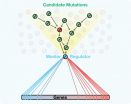(Press-News.org) CAMBRIDGE, Mass. (October 9, 2014) – Within almost every human cell is a nucleus six microns in diameter—about one 300th of a human hair's width—that is filled with roughly three meters of DNA. As the instructions for all cell processes, the DNA must be accessible to the cell's transcription machinery yet be compressed tightly enough to fit inside the nucleus. Scientists have long theorized that the way DNA is packaged affects gene expression. Whitehead Institute researchers present the first evidence that DNA scaffolding is responsible for enhancing and repressing gene expression.
"For the first time, we see that the structure of the chromosomes contributes to gene control," says Whitehead Member Richard Young, who is also a professor of biology at MIT. "In the past, there have been all kinds of ideas around how the structure might affect gene control, but now one has been experimentally tested and shown to be true."
DNA scaffolding has a hierarchy that ranges from beads-on-a-string, where a strand of DNA is wrapped around histone proteins to form a nucleosome, to topological associating domains akin to DNA balls containing multiple DNA loops interacting with various regulatory elements, to highly condensed chromosomes.
Working in mouse embryonic stem cells (ESCs), the Young lab examined the scaffolding landscape found within topologically associated domains. The researchers knew that proteins called Cohesin and CTCF are bound to the DNA around important ESC genes, but they did not know how these proteins affect the DNA's three-dimensional organization. Using a technique known as ChIA-PET, the researchers focused on how these proteins interact.
"By knowing which of the Cohesin/CTCF bound sites are coming together in physical proximity, we started to go from a linear view of the genome to sets of looping interactions, which led us to these domains, these super enhancer domains, where gene expression enhancement is contained within the loop," says Jill Dowen, a postdoctoral researcher in Young's lab.
Dowen and coauthors Zi Peng Fan, Denes Hnisz, and Gang Ren describe the structure of these loops in the latest online edition of the journal Cell.
Hnisz, also a postdoctoral researcher in Young's lab, likens the loops to "goody bags", with Cohesin and CTCF acting as the purse strings to create a DNA loop that cradles proteins enhancing or repressing gene expression. The enhancement or repression effects are confined to the genes within the goody bag. In the ESCs they studied, the scientists identified 197 Cohesin/CTCF-flanked loops that contain active genes and enhancers, and 349 loops that contain repressed genes.
Interestingly, when mouse neural precursor cells were examined for similar Cohesin/CTCF-bound loops, not only did the cells have such loops, but they were in similar locations as in the ESC genome. Of course, the repression or enhancement role of the loops differed between ESCs and the more differentiated cells. This indicates that the loops may remain constant during a cell's differentiation, although they may switch their contents, and therefore their effect on gene expression.
The researchers plan to study the loop structure and placement in other types of differentiated cells, but for now, they are excited about their new appreciation of DNA structure and its effects.
"I think we've filled in a major gap in the understanding of how gene expression is linked to the local organization of chromosomes," says Hnisz. "It will be exciting to explore whether defects in these mechanisms might even contribute to human disease."
INFORMATION:
This work is supported by National Institutes of Health (NIH, HG002668, CA168263-01A1), Austrian Science Fund (FWF, J3490), and Netherlands Organization for Scientific Research (NWO). Young is a founder of Syros Pharmaceuticals.
Written by Nicole Giese Rura
Richard Young's primary affiliation is with Whitehead Institute for Biomedical Research, where his laboratory is located and all his research is conducted. He is also a professor of biology at Massachusetts Institute of Technology.
Full Citation:
"Control of cell identity genes occurs in insulated neighborhoods in mammalian chromosomes"
Cell, October 9, 2014
Jill M. Dowen (1*), Zi Peng Fan (1,2*), Denes Hnisz (1*), Gang Ren (3,4*), Brian J. Abraham (1), Lyndon N. Zhang (1,5), Abraham S. Weintraub (1,5), Jurian Schuijers (1), Tong Ihn Lee (1), Keji Zhao (3), Richard A. Young (1,5).
1. Whitehead Institute for Biomedical Research, 9 Cambridge Center, Cambridge,
MA 02142
2. Computational and Systems Biology Program, Massachusetts Institute of Technology, Cambridge, MA 02139
3. Systems Biology Center, NHLBI, National Institutes of Health, 9000 Rockville
Pike, Bethesda, MD 20892, USA.
4. College of Animal Science and Technology, Northwest A&F University, Yangling, Shaanxi, P.R. China, 712100
5. Department of Biology, Massachusetts Institute of Technology, Cambridge, MA,
02139
* These authors contributed equally
BOSTON – The surprising discovery of a previously unidentified class of lipid molecules that enhance insulin sensitivity and blood sugar control offers a promising new avenue for the prevention and treatment of type 2 diabetes.
The new findings, made by a team of scientists from Beth Israel Deaconess Medical Center (BIDMC) and the Salk Institute, are described in the October 9 online issue of the journal Cell.
"We were blown away to discover this completely new class of molecules," says senior author Barbara Kahn, MD, Vice Chair of the Department of Medicine ...
Beer yeasts produce chemicals that mimic the aroma of fruits in order to attract flies that can transport the yeast cells to new niches, report scientists from VIB, KU Leuven and NERF in the reputed journal Cell Reports. Interestingly, these volatile compounds are also essential for the flavor of beverages such as beer and wine.
Kevin Verstrepen (VIB/KU Leuven): "The importance of yeast in beer brewing has long been underestimated. But recent research shows that the choice of a particular yeast strain or variety explains differences in taste between different beers and ...
A key mechanism behind diabetes may start in the brain, with early signs of the disease detectable through rising levels of molecules not previously linked to insulin signaling, according to a study led by researchers at the Icahn School of Medicine at Mount Sinai published today in the journal Cell Metabolism.
Past studies had found that levels of a key set of protein building blocks, branched-chain amino acids (BCAAs), are higher in obese and diabetic patient, and that this rise occurs many years before someone develops diabetes. Why and how BCAA breakdown may be ...
NEW YORK, NY (October 9, 2014)—Using an innovative algorithm that analyzes gene regulatory and signaling networks, Columbia University Medical Center (CUMC) researchers have found that loss of a gene called KLHL9 is the driving force behind the most aggressive form of glioblastoma, the most common form of brain cancer. The CUMC team demonstrated in mice transplants that these tumors can be suppressed by reintroducing KLHL9 protein, offering a possible strategy for treating this lethal disease. The study was published today in the online issue of Cell.
The team used ...
VIDEO:
Salk researchers explain how a new class of lipids may be tied to diabetes.
Click here for more information.
LA JOLLA—Scientists at the Salk Institute and Beth Israel Deaconess Medical Center (BIDMC) in Boston have discovered a new class of molecules—produced in human and mouse fat—that protects against diabetes.
The researchers found that giving this new fat, or lipid, to mice with the equivalent of type 2 diabetes lowered their elevated blood sugar, ...
New Rochelle, NY, October 9, 2014—Excessive and often lethal blood levels of bilirubin can result from mutations in a single gene that are the cause of the metabolic disease known as Crigler-Najjar syndrome type 1 (CNS1). A new gene therapy approach to correcting this metabolic error achieved significant, long-lasting reductions in bilirubin levels in a mouse model of CNS1 and is described in an Open Access article in Human Gene Therapy, a peer-reviewed journal from Mary Ann Liebert, Inc., publishers. The article is available on the Human Gene Therapy website at http://online.liebertpub.com/doi/full/10.1089/hum.2013.233. ...
TIFTON, GA – Weed control is one of the most challenging aspects of organic crop production. Most growers of certified organic crops rely heavily on proven cultural and mechanical weed control methods while limiting the use of approved herbicides. A new study of herbicides derived from clove oil tested the natural products' effectiveness in controlling weeds in Vidalia® sweet onion crops.
"Cultivation with a tine weeder and hand weeding are the primary tools currently used for weed control in organic sweet onion (Allium ceps)," explained scientist W. Carroll ...
IZMIR, TURKEY – Tomatoes are known to be rich in antioxidants such as vitamin C, lycopene, β-carotene, and phenolics. Antioxidants, substances capable of delaying or inhibiting oxidation processes caused by free radicals, are of interest to consumers for their health-related contributions, and to plant breeders for their ability to provide plants with natural resistance to biotic and abiotic stresses. While tomato domestication and breeding programs have typically focused on traits such as fruit weight, color, shape, and disease resistance, scientists are now ...
In an analysis of more than 8,000 episodes of Staphylococcus aureus bloodstream infections, there were no significant differences in the risk of death when comparing patients exhibiting less susceptibility to the antibiotic vancomycin to patients with more vancomycin susceptible strains of S. aureus, according to a study published in JAMA. The study is being released early online to coincide with the IDWeek 2014 meeting.
Staphylococcus aureus is among the most common causes of health care-associated infection throughout the world. It causes a wide range of infections, ...
PHILADELPHIA – Hospitalized children go home sooner and are less likely to be readmitted when the hospital has an antibiotic stewardship program that's dedicated to controlling antibiotic prescriptions and treatment, according to a study being presented at IDWeek 2014™. The study is the first to show the benefits of such programs on children's health.
Antibiotic stewardship programs are increasingly being used to manage how and when antibiotics are being prescribed in hospitals and other health care facilities across the country. Often led by epidemiologists or ...



